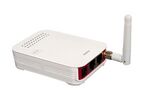Accton MR3202A
From TechInfoDepot
Jump to navigationJump to search
| bg (G54) | |
|---|---|
| 802.11b/g Mini AP Router | |
 | |
| InfoDepot Wiki | Accton MR3202A |
| WikiDevi.wi-cat.ru | Accton MR3202A |
| 3rd Party Firmware | |
| dd-wrt | Supported |
| OpenWrt | Status Unknown |
| Tomato any flavor | Incompatible |
| Gargoyle | Status Unknown |
| Platform | |
| Brand • Model • Rev | Accton MR3202A |
| FCC ID (fcc.io) | HEDMR3202A |
| FCC ID (fcc.report) | HEDMR3202A |
| Type | wireless router |
| CPU1 | Atheros AR2317 |
| CPU1 Type | MIPS 4KEc |
| CPU1 Speed | 180 MHz |
| Flash1 Chip | STMicro Model? |
| Flash1 Size | ? MiB |
| RAM1 Size | 16 MiB 16,777,216 B <br />131,072 Kib <br />16,384 KiB <br />128 Mib <br />0.0156 GiB <br /> |
| RAM1 Chip | SK hynix HY57V281620ETP-H |
| ETH chip1 | Brand? Model? |
| Switch | Infineon ADM6996FC |
| Ethernet Port Count |
1-WAN 1-100MbE-LAN |
| Wired Standard | IEEE 802.3i/3u |
| Expansion IF types | none specified |
| Power | 5 VDC, 2 A |
| Connector type | barrel |
|
| |
|
| |
| Other | |
|
Default SSID: Wireless Network 1 | |
| Manuf/OEM/ODM | Accton |
| 3rd Party Firmware Support |
DD-WRT • (List) |
| Retail | |
| FCC approval date | 31 August 2007 |
| Radio 1 | |
| Chip1 | Atheros AR2317 |
| Wireless interface OUI | 00:12:CF |
| Antenna Connector Type | RP-SMA |
| Wireless Standard | IEEE 802.11b/g |
| 802.11g | up to 54 Mbps |
| 802.11b | up to 11 Mbps |
| WiFi Operating Frequency | 2.4 GHz |
For a list of all currently documented Atheros (QCA) chipsets with specifications, see Atheros.
For a list of all currently documented Infineon (Lantiq) chipsets with specifications, see Infineon.
For a list of all currently documented Accton devices with specifications, see Accton.
- • 54 Mbps - 2.4GHz 802.11g = G54 class
Overview
"141320220000E R01" is silkscreened on the board in the FCC photos.
Default settings (and a presumed used OUI [00:12:CF]) is per the FCC manual.
- The manual shows screenshots of the web UI indicating that the stock firmware is based on X-Wrt and OpenWrt (with a GPLv2 notice).
- Default SSIDs per additional new VIF follow the Wireless Network X pattern (next VIF being 2, one after that being 3, etc).
Categories:
- Accton
- Embedded system/wireless router
- Embedded System Atheros
- Embedded System AR2317
- Atheros
- Embedded System MIPS 4KEc
- Embedded System
- Embedded System Infineon
- Embedded System ADM6996FC
- Infineon
- Manuf Accton
- DD-WRT Supported
- Embedded System IEEE 802.11b/g
- Single-Radio Wireless Embedded System
- Wireless Embedded System
- Single-Band
- English Documentation